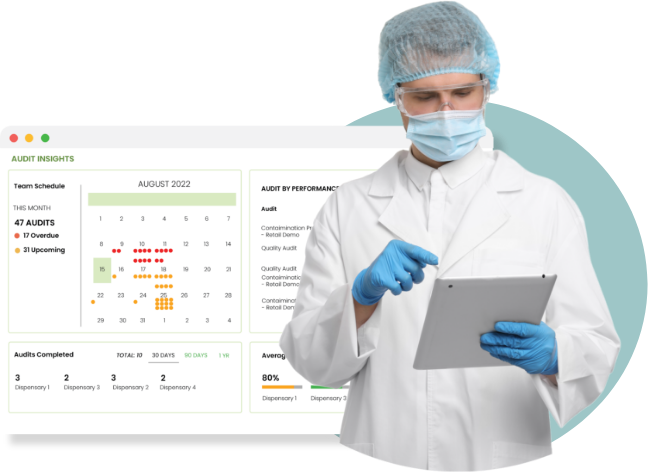Author: Ben Hartman | August 12, 2025 | 5 Min Read
How to Build Better Safety Training with Accountability, Leadership, and Culture

Amid highly publicized food safety recalls and cuts made by the Trump Administration to the government agencies that oversee the food manufacturing industry, the American public is concerned about the safety of their food.
According to a new survey, consumer confidence in the safety of the country’s food supply is at an all-time low. The respondents noted various reasons for this drop in confidence and steps that can be taken to improve food safety, including stricter government regulation and more transparency about how food companies and government agencies keep food safe.
But what can food companies do to fight this worsening public perception of food safety? We spoke to Stacey Brown, Food Safety Auditor and Consultant for ASI and winner of the 2025 Excellence in SQF Auditing Award, about how companies can create smarter, more effective, and efficient food safety training and a company culture that fosters safety, risk management, and more impactful training.
It Starts with Leadership
In our recent Rootwurks survey, we asked food industry professionals to name their most difficult training challenges. “Lack of leadership buy-in” was consistently named as a top food safety training challenge - including among respondents who are themselves in senior management.
“It’s the leadership that develops the company culture, maintains it, and holds people accountable, including themselves. They’re the ones who drive the culture because they have the power to drive it.”
But beyond simply getting leadership to agree to invest the time and money needed for safety training, senior leadership must also lead by example.
“If your senior leadership is out on the production floor not following good manufacturing practices, or they aren’t washing their hands or wearing PPE, why is anybody else going to do it?” Brown asked.
“It all starts with senior leadership and making sure to hold everyone accountable.”
Brown also said that employees need to feel empowered to point out bad safety practices - including when carried out by company leadership.
Focus on Your Culture
A strong safety culture means that your team members do things the right way even when nobody is watching. But safety culture doesn’t stand alone.
“We talk a lot about food safety culture, but food safety culture is just one piece of the overall company culture. If you don't have a good company culture, you're not going to have a good food safety culture. You're not gonna have an overall safety culture,” Brown said.
Brown said that culture is a set of beliefs and norms backed by the trust that a company has and that everyone adheres to on their own.
“It means everybody is adhering to good food safety practices even when they know the boss isn’t there. Or it's being audit-ready or meeting cGMPs even when an auditor isn’t present.”
Build a Training Plan and Follow-up
Brown said that too many companies see employee training as an obligation to race through, with a focus on quantity and getting back to the production floor. Instead, she said the emphasis must be on the quality of the training and follow-up.
“It’s not about quantity, it's quality. Most people don't know how to train other people. We’re good information dumpers; we read the policy to employees, tell them how to do something, check the box, and say we trained people. But there’s no follow-up and no accountability.”
Brown said that companies can’t just check a box and move on. They need to have a plan for how they initiate and perform training and for confirming that employees understand the training.
“You have to verify training - it's the quality of the training we’re giving, it’s about doing it better, not faster,” Brown said.
She said that companies should develop 30, 60, or 90-day plans to verify training throughout the year so that they can identify employee training gaps and where more focus is needed. They can’t view training as a one-time event and should practice continuous reinforcement, including the use of visual aids, to regularly reinforce key safety concepts in order to help employees retain training.
“It's a constant verification throughout the year,” Brown said, adding, “if you’re constantly reinforcing it [training], it's going to go from short-term memory into long-term memory.”
Hold Everyone Accountable
The best employee training courseware and methods can only go so far if employees and leadership are not held accountable for safety.
“Accountability is where the rubber meets the road. Because a lot of times in food safety, people are not held accountable, and that’s where it fails.”
Brown said that when performing audits on food facilities, if she sees a non-conformity, she’s often told that the company has retrained, but not that someone has been held accountable for the shortcomings.
“It's an accountability issue. It doesn’t take much to hold people accountable. It can be a simple write-up, but if you hold one or two people accountable, people will fall in line.”
Brown said that accountability can also help prevent non-conformances - and the punishments they entail - from becoming more severe.
“[for auditors] It’s not so much that you made a mistake or that you’re missing something. It’s that you are aware of it and didn't correct it in the time you had to do it.”
Audit Your Safety System
In terms of training reinforcement, internal audits can be a highly effective way to verify and validate that employees are retaining what they’ve learned about safety. But they must be thorough and rigorous.
“An internal audit should ask the same questions [as a third-party audit]. There should be very little difference between an internal audit and a site inspection. They should be challenging and difficult,” Brown said.
She added that the people in the company responsible for supervising internal audits and inspections should interview employees and challenge them on their awareness of key safety principles to verify the efficacy of the company’s food safety system.
Set Goals for Training
To make training more efficient and effective, companies must set goals and clear standards.
Brown said this entails developing key performance indicators for safety training to better determine where the company needs to invest more resources in training and which tools could potentially enhance training.
“It’s about where we want to go, and this is how we’re going to get there. This is how we're going to measure our training, and these are the tools we need to implement it.”
Brown said sometimes the resource needed is more employees, or creating a system in which every employee isn’t wearing four or five different hats. Instead, the company should determine which safety tasks are best suited for which people.
One overarching theme throughout all of these training guidelines is that it’s not a one-and-done matter. It must be a constant feature of company operations and part of a mission of continuous improvement.
“People look at training like it’s a moment in time, but it’s a constant thing. We’re always learning, and the point is to have continuous improvement. We should always be looking at how we can do better and be better,” Brown said.
To read the results of the Rootwurks survey on food safety training, download our free guide “The Biggest Challenges in the Food Manufacturing Industry here.
Rootwurks Training: Cut Downtime without Cutting Corners
At Rootwurks, we’ve developed a fully customizable food safety training and compliance adherence platform that helps companies build more streamlined, targeted, and effective training for food safety and risk management.
To learn more about our solutions, reach out to the Rootwurks team here:
Contributors

Ben Hartman
From HACCP certification to the basics of hygiene, our on-demand courseware has you covered.





.jpg?width=120&height=80&name=Baby%20(1).jpg)




